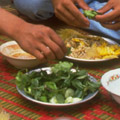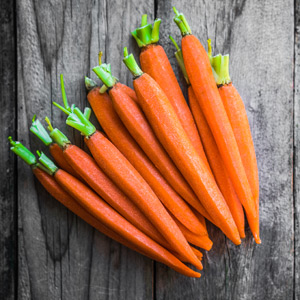 The following is a “healthy food hot list” that give you the biggest nutritional bang for your caloric buck, as well as decrease your risk for cancer, diabetes and heart disease. Along with each description is a suggestion as to how to incorporate these power-foods into your diet.
The following is a “healthy food hot list” that give you the biggest nutritional bang for your caloric buck, as well as decrease your risk for cancer, diabetes and heart disease. Along with each description is a suggestion as to how to incorporate these power-foods into your diet.
Power-foods list from: http://www.bellybytes.com/articles/29foods.shtml
FRUITS
01. Apricots
The Power: Beta-carotene, which helps prevent free-radical damage and protect the eyes. The body also turns beta-carotene into vitamin A, which may help ward off some cancers, especially of the skin. One apricot has 17 calories, 0 fat, 1 gram of fiber. Snacks on them dried, or if you prefer fresh, buy when still firm; once they soften, they lose nutrients.
02. Avocados
The Power: Oleic acid, an unsaturated fat that helps lower overall cholesterol and raise levels of HDL, plus a good dose of fiber. One slice has 81 calories, 8 grams of fat and 3 grams of fiber. Try a few slices instead of mayonnaise to dress up your next burger.
03. Raspberries
The Power: Ellagic acid, which helps stall cancer-cell growth. These berries are also packed with vitamin C and are high in fiber, which helps prevent high cholesterol and heart disease. A cup has only 60 calories, 1 gram of fat and 8 grams of fiber. Top plain low-fat yogurt or oatmeal (another high fiber food) with fresh berries.
04. Mango
The Power: A medium mango packs 57mg of vitamin C, almost your whole-recommended daily dose. This antioxidant helps prevent arthritis and boosts wound healing and your immune system. Mangoes also boast more than 8,000 IU of vitamin A (as beta-carotene). One mango has 135 calories, 1 gram of fat and 4 grams of fiber. Cut on up and serve it over leafy greens. Bonus: Your salad will taste like dessert!
05. Cantaloupe
The Power: Vitamin C (117mg in half a melon, almost twice the recommended daily dose) and beta-carotene – both powerful antioxidants that help protect cells from free-radical damage. Plus, half a melon has 853mg of potassium – almost twice as much as a banana, which helps lower blood pressure. Half a melon has 97 calories, 1 gram of fat and 2 grams of fiber. Cut into cubes and freeze, then blend into an icy smoothie.
06. Cranberry Juice
The Power: Helps fight bladder infections by preventing harmful bacteria from growing. A cup has 144 calories, 0 grams of fat and 0 fiber. Buy 100 percent juice concentrate and use it to spice up your daily H20 without adding sugar.
07. Tomato
The Power: Lycopene, one of the strongest carotenoids, acts as an antioxidant. Research shows that tomatoes may cut the risk of bladder, stomach and colon cancers in half if eaten daily. A tomato has 26 calories, 0 fat and 1 gram of fiber. Drizzle fresh slices with olive oil, because lycopene is best absorbed when eaten with a little fat.
08. Raisins
The Power: These little gems are a great source of iron, which helps the blood transport oxygen and which many women are short on. A half-cup has 218 calories, 0 fat and 3 grams of fiber. Sprinkle raisins on your morning oatmeal or bran cereal – women, consider this especially during your period.
09. Figs
The Power: A good source of potassium and fiber, figs also contain vitamin B6, which is responsible for producing mood-boosting serotonin, lowering cholesterol and preventing water retention. The Pill depletes B6, so if you use this method of birth control, make sure to get extra B6 in your diet. One fig has 37 to 48 calories, 0 fat and 2 grams of fiber. (Cookie lovers – fig bars have around 56 calories, 1 gram of fat and 1 gram of fiber per cookie). Dried figs make a great portable gym snack.
10. Lemons/Limes
The Power: Limonene, furocoumarins and vitamin C, all of which help prevent cancer. A wedge has 2 calories, 0 fat and 0 fiber. Buy a few of each and squeeze over salads, fish, beans and vegetables for fat free flavor.
VEGETABLES
11. Onions
The Power: Quercetin is one of the most powerful flavonoids (natural plant antioxidants). Studies show it helps protect against cancer. A cup (chopped) has 61 calories, 0 fat and 3 grams of fiber. Chop onions for the maximum phyto-nutrient boost, or if you hate to cry, roast them with a little olive oil and serve with rice or other vegetables.
12. Artichokes
The Power: These odd-looking vegetables contain silymarin, an antioxidant that helps prevent skin cancer, plus fiber to help control cholesterol. One medium artichoke has 60 calories, 0 fat and 7 grams of fiber. Steam over boiling water for 30 to 40 minutes. Squeeze lemon juice on top, then pluck the leaves off with your fingers and use your teeth to scrape off the rich-tasting skin. When you get to the heart, you have found the best part!
13. Ginger
The Power: Gingerols may help reduce queasiness; other compounds may help ward off migraines and arthritis pain by blocking inflammation-causing prostaglandins. A teaspoon of fresh gingerroot has only 1 calorie, 0 fat and 0 fiber. Peel the tough brown skin and slice or grate into a stir-fry.
14. Broccoli
The Power: Indole-3-carbinol and sulforaphane, which help protect against breast cancer. Broccoli also has lots of vitamin C and beta-carotene. One cup (chopped) has 25 calories, 0 fat and 3 grams of fiber. Don’t overcook broccoli – instead, microwave or steam lightly to preserve phytonutrients. Squeeze fresh lemon on top for a zesty and taste, added nutrients and some vitamin C.
15. Spinach
The Power: Lutein and zeaxanthin, carotenoids that help fend off macular degeneration, a major cause of blindness in older people. One cup has 7 calories, 0 fat and 1 gram of fiber. Add raw leaves to a salad or saute with a little olive oil and garlic.
16. Bok Choy (Chinese cabbage)
The Power: Brassinin, which some research suggests may help prevent breast tumors, plus indoles and isothiocyanates, which lower levels of estrogen, make this vegetable a double-barreled weapon against breast cancer. A cup will also give you 158mg of calcium (16 percent of your daily recommended requirement) to help beat osteoporosis. A cup (cooked) has 20 calories, 0 fat and 3 grams of fiber. Find it in your grocer’s produce section or an Asian market. Slice the greens and juicy white stalks, then saute like spinach or toss into a stir-fry just before serving.
17. Squash (Butternut, Pumpkin, Acorn)
The Power: Winter squash has huge amounts of vitamin C and beta-carotene, which may help protect against endometrial cancer. One cup (cooked) has 80 calories, 1 gram of fat and 6 grams of fiber. Cut on in half, scoop out the seeds and bake or microwave until soft, then dust with cinnamon.
18. Watercress and Arugula
The Power: Phenethyl isothiocyanate, which, along with beta-carotene and vitamins C and E, may help keep cancer cells at bay. One cup has around 4 calories, 0 fat and 1 gram of fiber. Do not cook these leafy greens; instead, use them to garnish a sandwich or add a pungent, peppery taste to salad.
19. Garlic
The Power: The sulfur compounds that give garlic its pungent flavor can also lower LDL (“bad”) cholesterol, lower blood pressure and even reduce your risk of stomach and colon cancer. A clove has 4 calories, 0 fat and 0 fiber. Bake a whole head for 15 to 20 minutes, until soft and sweet and spread on bread instead of butter.
GRAINS/BEANS/NUTS
20. Quinoa
The Power: A half-cup of cooked quinoa has 5 grams of protein, more than any other grain, plus iron, riboflavin and magnesium. A half-cup has 318 calories, 5 grams of fat and 5 grams of fiber. Add to soup for a protein boost. Rinse first, or it will taste bitter.
21. Wheat Germ
The Power: A tablespoon gives you about 7 percent of your daily magnesium, which helps prevent muscle cramps; it is also a good source of vitamin E. One tablespoon has 27 calories, 1 gram of fat and 1 gram of fiber. Sprinkle some over yogurt, fruit or cereal.
22. Lentils
The Power: Isoflavones, which may inhibit estrogen-promoted breast cancers, plus fiber for heart health and an impressive 9 grams of protein per half cup. A half-cup (cooked) has 115 calories, 0 fat and 8 grams of fiber. Isoflavones hold up through processing, so buy lentils canned, dried or already in soup. Take them to work, and you will have a protein packed lunch.
23. Peanuts
The Power: Studies show that peanuts or other nuts (which contain mostly unsaturated “good” fat) can lower your heart-disease risk by over 20 percent. One ounce has 166 calories, 14 grams of fat and 2 grams of fiber. Keep a packet in your briefcase, gym bag or purse for a protein-packed post-workout nosh or an afternoon pick me up that will satisfy you until supper, or chop a few into a stir-fry for a Thai accent.
24. Pinto Beans
The Power: A half cup has more than 25 percent of your daily requirement of folate, which helps protect against heart disease and reduces the risk of birth defects. A half-cup (canned) has 103 calories, 1 gram of fat and 6 grams of fiber. Drain a can, rinse and toss into a pot of vegetarian chili. FOR MORE INFO. CHECK OUR NATURAL HEALTH CATEGORY.
Resource for article: BellyBytes.com
All material in this list is copyright BellyBytes.com












